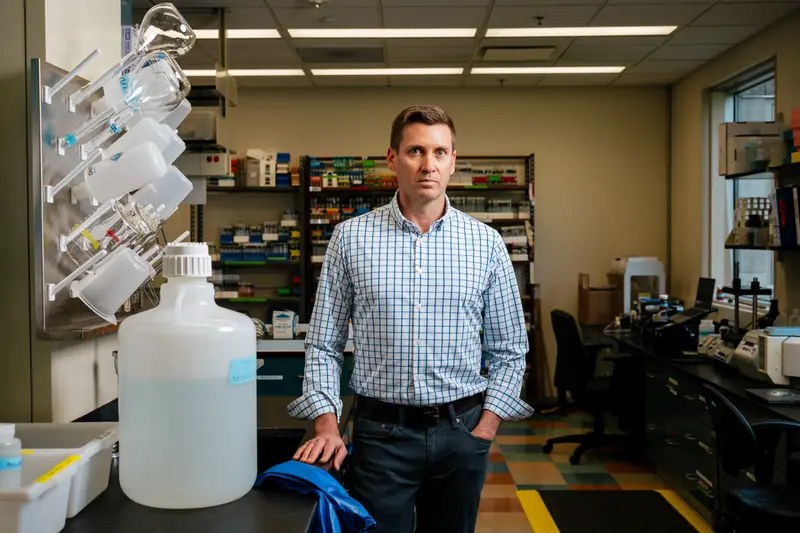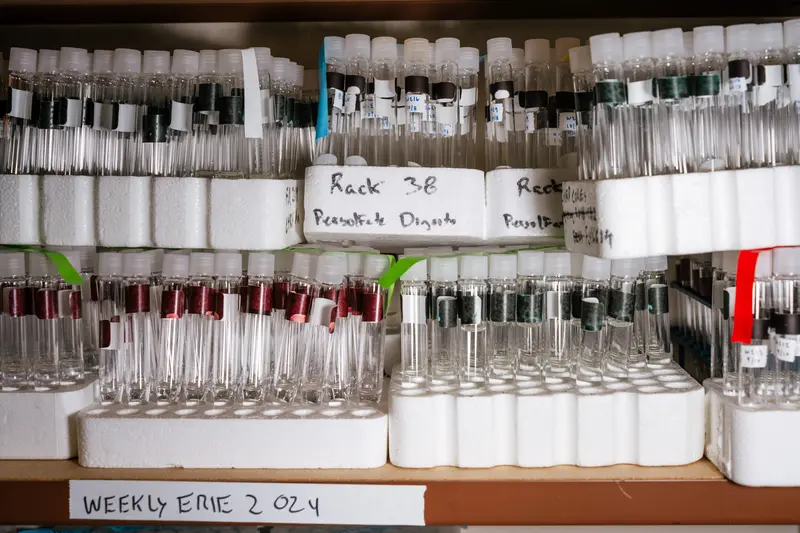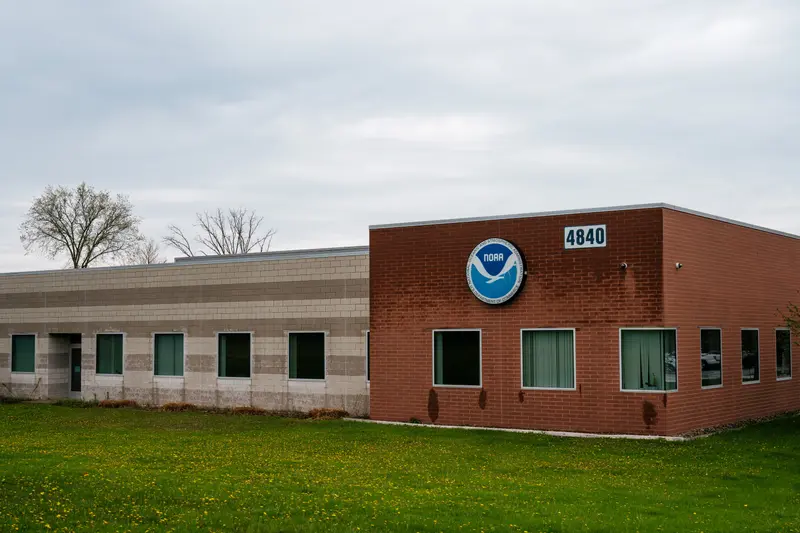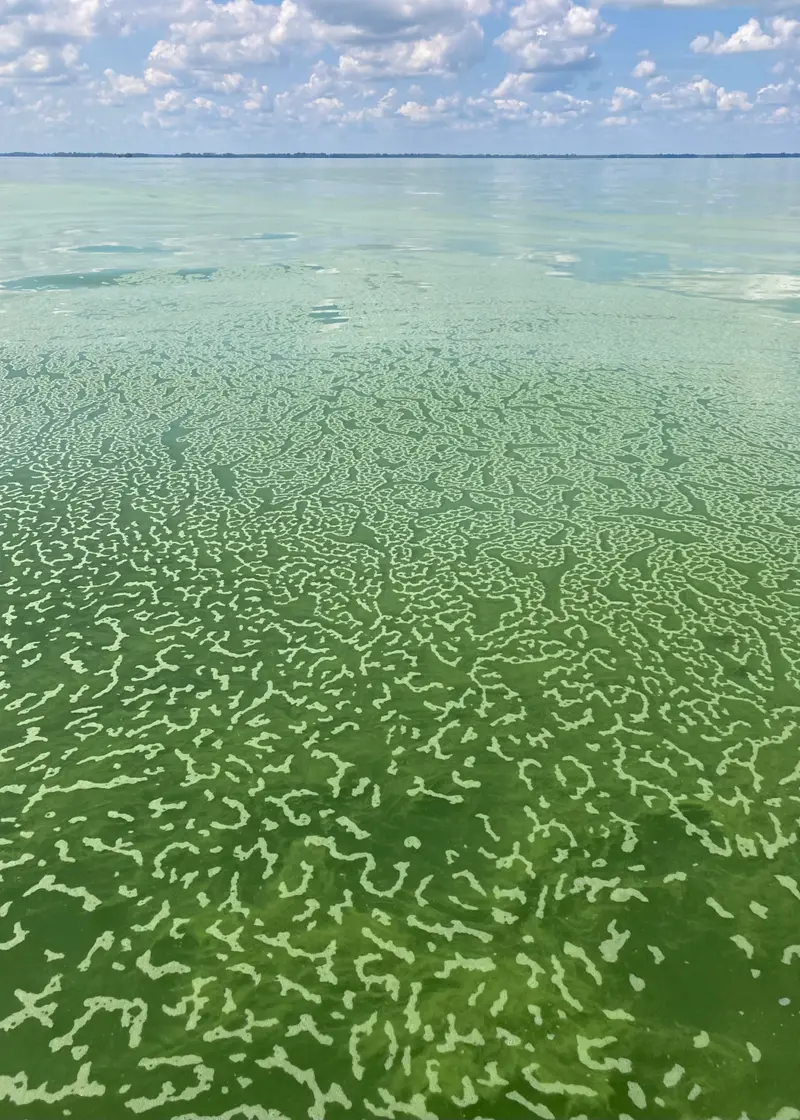Just one year ago, JD Vance was a leading advocate of the Great Lakes and the efforts to restore the largest system of freshwater on the face of the planet.
As a U.S. senator from Ohio, Vance called the lakes “an invaluable asset” for his home state. He supported more funding for a program that delivers “the tools we need to fight invasive species, algal blooms, pollution, and other threats to the ecosystem” so that the Great Lakes would be protected “for generations to come.”
But times have changed.
This spring, Vance is vice president, and President Donald Trump’s administration is imposing deep cuts and new restrictions, upending the very restoration efforts that Vance once championed. With the peak summer season just around the corner, Great Lakes scientists are concerned that they have lost the ability to protect the public from toxic algal blooms, which can kill animals and sicken people.
Cutbacks have gutted the staff at the Great Lakes Environmental Research Laboratory, part of the National Oceanic and Atmospheric Administration. Severe spending limits have made it difficult to purchase ordinary equipment for processing samples, such as filters and containers. Remaining staff plans to launch large data-collecting buoys into the water this week, but it’s late for a field season that typically runs from April to October.
In addition to a delayed launch, problems with personnel, supplies, vessel support and real-time data sharing have created doubts about the team’s ability to operate the buoys, said Gregory Dick, director of the NOAA cooperative institute at the University of Michigan that partners with the lab. Both the lab and institute operate out of a building in Ann Arbor, Michigan, that was custom built as NOAA’s hub in the Great Lakes region, and both provide staff to the algal blooms team.
“This has massive impacts on coastal communities,” Dick said.

Credit:
Nick Hagen for ProPublica
Multiple people who have worked with the lab also told ProPublica that there are serious gaps in this year’s monitoring of algal blooms, which are often caused by excess nutrient runoff from farms. Data generated by the lab’s boats and buoys, and publicly shared, could be limited or interrupted, they said.
That data has helped to successfully avoid a repeat of a 2014 crisis in Toledo, Ohio, when nearly half a million people were warned to not drink the water or even touch it.
If the streams of information are cut off, “stakeholders will be very unhappy,” said Bret Collier, a branch chief at the lab who oversaw the federal scientists that run the harmful algal bloom program for the Great Lakes. He was fired in the purge of federal probationary workers in February.
The lab has lost about 35% of its 52-member workforce since February, according to the president of the lab’s union, and it was not allowed to fill several open positions. The White House released preliminary budget recommendations last week that would make significant cuts to NOAA. The budget didn’t provide details, but indicated the termination of “a variety of climate-dominated research, data, and grant programs, which are not aligned with Administration policy” of ending “‘Green New Deal’ initiatives.”
An earlier document obtained by ProPublica and reported widely proposed a 74% funding cut to NOAA’s research office, home of the Great Lakes lab.
Vance’s office didn’t respond to questions from ProPublica about how federal cuts have affected Great Lakes research. The White House also didn’t respond to messages.

Credit:
Nick Hagen for ProPublica
Municipal water leaders in Cleveland and Toledo have written public letters of support on behalf of the lab, advocating for the continuation of its work because of how important its tools and resources are for drinking water management.
In a statement to ProPublica, staffers from Toledo’s water system credited the Great Lakes lab and NOAA for alerting it to potential blooms near its intake days ahead of time. This has saved the system significant costs, they said, and helped it avoid feeding excess chemicals into the water.
“The likelihood of another 2014 ‘don’t drink the water’ advisory has been minimized to almost nothing by additional vigilance” from both the lab and local officials, they said.
Remaining staff have had to contend with not only a lack of capacity but also tight limits on spending and travel.
Several people who have worked in or with the lab said that the staff was hampered by strict credit card limits imposed on government employees as part of the effort to reduce spending by the Department of Government Efficiency, which has been spearheaded by presidential adviser Elon Musk.
“The basic scientific supplies that we use to provide the local communities with information on algal bloom toxicity — our purchasing of them is being restricted based on the limitations currently being put in by the administration,” Collier said.

Credit:
Nick Hagen for ProPublica
NOAA and the Department of Commerce, which oversees the agency, didn’t respond to messages from ProPublica. Neither did a DOGE official. Eight U.S. senators, including the minority leader, sent a letter in March to a top NOAA leader inquiring about many of the changes, but they never received a response.
The department described its approach to some of its cuts when it eliminated nearly $4 million in funding for the NOAA cooperative institute at Princeton University and emphasized the importance of avoiding wasteful government spending. ProPublica has reported on how the loss of research grants at Princeton and the more significant defunding of the NOAA lab it works with would be a serious setback for weather and climate preparedness.
A number of the staffing losses at the Great Lakes lab came when employees accepted offers of early retirement or voluntary separation; others were fired probationary workers targeted by DOGE across the government. That includes Collier, who had 24 years of professional experience, largely as a research professor, before he was hired last year into a position that, according to the lab’s former director, had been difficult to fill.
A scientist specializing in the toxic algal blooms was also fired. She worked on the team for 14 years through the cooperative institute before accepting a federal position last year, which made her probationary, too.
A computer scientist who got real-time data onto the lab’s website — and the only person who knew how to push out the weekly sampling data on harmful algal blooms — was also fired. She was probationary because she too was hired for a federal position after working with the institute.
And because of a planned retirement, no one holds the permanent position of lab director, though there is an acting director. The lab isn’t allowed to fill any positions due to a federal hiring freeze.
At the same time, expected funds for the lab’s cooperative institute are delayed, which means, Dick said, it may soon lay off staff, including people on the algal blooms team.
In March, Cleveland’s water commissioner wrote a letter calling for continued support for the Great Lakes lab and other NOAA-funded operations in the region, saying that access to real-time forecasts for Lake Erie are “critically important in making water treatment decisions” for more than 1.3 million citizens.
In 2006, there was a major outbreak of hypoxia, an issue worsened by algal blooms where oxygen-depleted water can become corrosive, discolored and full of excess manganese, which is a neurotoxin at high levels. Cleveland Water collaborated with the lab on developing a “groundbreaking” hypoxia forecast model, said Scott Moegling, who worked for both the Cleveland utility and Ohio’s drinking water regulatory agency.
“I knew which plants were going to get hit,” Moegling said. “I knew about when, and I knew what the treatment we would need would be, and we could staff accordingly.”
The American Meteorological Society, in partnership with the National Weather Association, spotlighted this warning system in its statement in support of NOAA research, saying that it helps “keep drinking water potable in the Great Lakes region.”
Collier, the former branch chief, said that quality data may be lacking this year, not just for drinking water suppliers, but also the U.S. Coast Guard, fisheries, shipping companies, recreational businesses and shoreline communities that rely on it to navigate risk. In response to a recent survey of stakeholders, the president of a trade organization serving Great Lakes cargo vessels said that access to NOAA’s real-time data “is critically important to the commercial shipping fleet when making navigation decisions.”
Because federal law requires NOAA to monitor harmful algal blooms, the cuts may run against legal obligations, several current and former workers told ProPublica. The blooms program was “federally mandated to be active every single day, without exception,” Collier said.


Credit:
The Cooperative Institute of Great Lakes Research at the University of Michigan
The 2024 bloom in Lake Erie was the earliest on record. At its peak, it covered 550 square miles. Warming temperatures worsen the size and frequency of algal blooms. While the field season was historically only about 90 days, Collier said, last year the team was deployed for 211 days.
As the shallowest of the Great Lakes, Lake Erie is typically first to show signs of problems. But it’s also an emblem of environmental stewardship, thanks to its striking recovery from unchecked industrial pollution. The lake was once popularly declared “dead.” A highly publicized fire inflamed a river that feeds into it. Even Dr. Seuss knocked it in the 1971 version of “The Lorax.” The book described fish leaving a polluted pond “in search of some water that isn’t so smeary. I hear things are just as bad up in Lake Erie.”
But the rise of agencies like the Environmental Protection Agency and NOAA, and labs like the one protecting the Great Lakes, along with legislation that protected water from pollution, led to noticeable changes. By 1986, two Ohio graduate students had succeeded in persuading Theodor Geisel, the author behind Dr. Seuss, to revise future editions of his classic book.
“I should no longer be saying bad things about a body of water that is now, due to great civic and scientific effort, the happy home of smiling fish,” Geisel wrote to them.
Early this year, headlines out of the Midwest suggested that “Vance could be a game-changing Great Lakes advocate” and that he might “save the Great Lakes from Trump.”
A 2023 report to Congress about the Great Lakes Restoration Initiative, a popular funding mechanism for projects that protect the lakes, including the research lab’s, described the lab’s work on harmful algal blooms as one of its “success stories.” Last year, with Vance as a co-sponsor, an act to extend support for the funding program passed the Senate, but stalled in the House. Another bipartisan effort to reauthorize it launched in January.

Credit:
Nick Hagen for ProPublica
Project 2025, the plan produced by the Heritage Foundation for Trump’s second term, recommended that the president consider whether NOAA “should be dismantled and many of its functions eliminated, sent to other agencies, privatized, or placed under the control of states and territories.”
NOAA is “a colossal operation that has become one of the main drivers of the climate change alarm industry,” the plan said, and this industry’s mission “seems designed around the fatal conceit of planning for the unplannable.”
“That is not to say NOAA is useless,” it added, “but its current organization corrupts its useful functions. It should be broken up and downsized.”
When asked at his confirmation hearing in January if he agreed with Project 2025’s recommendation of dismantling NOAA, Howard Lutnick, head of the commerce department, said no.
One month later, the Great Lakes lab’s probationary staff got termination notices. That includes Nicole Rice, who spent a decade with NOAA. A promotion made her communications job vulnerable to the widespread firings of federal probationary workers.
In recent testimony to a Michigan Senate committee, Rice expressed deep concern about the future of the Great Lakes.
“It has taken over a century of bipartisan cooperation, investment and science to bring the Great Lakes back from the brink of ecological collapse,” Rice said. “But these reckless cuts could undo the progress in just a few short years, endangering the largest surface freshwater system in the world.”
Vernal Coleman contributed reporting.
]



